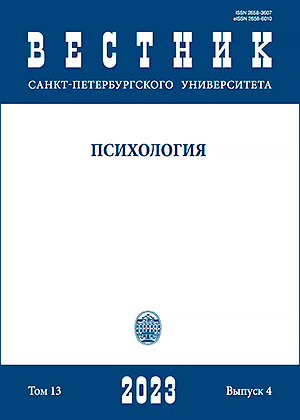Взаимосвязь представлений о детском опыте и характеристик переживания стыда у взрослых
DOI:
https://doi.org/10.21638/spbu16.2023.407Аннотация
Стыд может мотивировать социальное поведение для реабилитации своего положительного образа в глазах других людей, но если такая реабилитация не кажется возможной, он же мотивирует избегание социального взаимодействия. На данный момент не существует единого понимания того, почему человек может недооценивать возможность реабилитироваться в глазах окружающих, но исследования позволяют предположить роль неблагоприятного детского опыта. Люди с таким опытом могут испытывать посттравматические симптомы вторжения, избегания и возбуждения в ответ на ситуации переживания стыда. Поскольку эти симптомы связаны с чувствами бессилия и отчуждения, человек может недооценивать возможность реабилитироваться при переживании стыда и избегать социального взаимодействия. Цель исследования — изучить связь представлений о неблагоприятном детском опыте со склонностью к стыду у взрослых. В исследовании приняли участие 73 человека (60 женщин, 13 мужчин), средний возраст — 23 года. Представления о детском опыте изучались с помощью опросника виктимизации в детском возрасте (JVQ), характеристики стыда — с помощью шкалы оценки влияния травматического события (ШОВТС), методики измерения склонности к стыду и вине (GASP) и модифицированной процедуры оценки поведения при стыде, предложенной де Хооге и коллегами. Использовались сравнительный, факторный и регрессионный анализы. Обнаружено, что детский опыт психологической травли, физического нападения и сексуализированного насилия на фоне пренебрежения связан с более высоким посттравматическим стрессом в ответ на ситуации переживания стыда во взрослом возрасте. Участники с более высоким уровнем посттравматического стресса сообщают о большей склонности к избегающему поведению при стыде. Неблагоприятный детский опыт может способствовать развитию посттравматического стресса в ответ на ситуации переживания стыда. Как следствие, человек может недооценивать вероятность социальной поддержки и избегать социального взаимодействия при стыде.
Ключевые слова:
стыд, неблагоприятный детский опыт, социальное избегание, посттравматический стресс
Скачивания
Библиографические ссылки
References
Загрузки
Опубликован
Как цитировать
Выпуск
Раздел
Лицензия
Статьи журнала «Вестник Санкт-Петербургского университета. Психология» находятся в открытом доступе и распространяются в соответствии с условиями Лицензионного Договора с Санкт-Петербургским государственным университетом, который бесплатно предоставляет авторам неограниченное распространение и самостоятельное архивирование.




